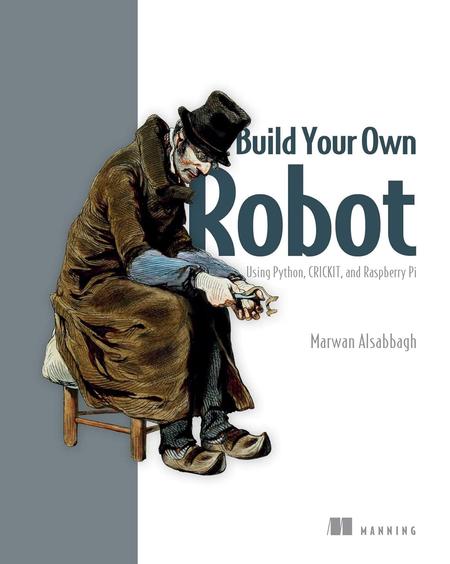English | MP4 | AVC 1280×720 | AAC 44KHz 2ch | 6h 6m | 856 MB
A DIY guide to bringing your first robot to life with cheap and basic components.
Build Your Own Robot introduces you to the exciting world of robotics in a way that’s fun and affordable! You’ll build your own real robot with easy-to-find hardware and free open source software. Plus, all the components you need can be assembled with simple tools like a screwdriver.
In Build Your Own Robot you’ll learn how to:
- Use cameras to capture photos and let your robot see
- Add cameras and basic computer vision
- Coordinate DC motors to move your robot
- Write a web app to control your robot
- Set up controls for joysticks
- Read QR codes to find and identify objects
This book shows you how anyone can start building their own robot—no special soldering or electronic skills required. All you need is some basic Python know-how to get started. From scratch, you’ll go hands-on with DC motors, touch sensors, custom shell scripting, joystick controls, and even face detection for your robot friend.
You can build your own robot! With this book, you’ll use readily-available hardware and author Marwan Alsabbagh’s clear step-by-step instructions to create a robot that moves, manipulates objects, and responds to its environment. Along the way, you’ll learn some serious skills like computer vision, networking, and the basics of robotics programming.
Build Your Own Robot is a project-based guide that takes you from spinning your first DC motor to programming a mobile robot that you can control from your phone or computer. You’ll write simple Python code to help your new friend spin, move, and find its way. You’ll even teach it to track faces and fetch snacks. Plus, a helpful hardware purchasing guide makes it easy to find exactly what you need to get started!
What’s inside
- Coordinate DC motors to move your robot
- Write a web app to control your robot
- Adding cameras and basic computer vision
- Read QR codes to find and identify objects
Table of Contents
1 Our approach to making robots
2 Summary
3 What are robots made of
4 What is a robot
5 Changing Neopixel colors
6 Checking the touch sensor state
7 Configuring the software for our robots
8 Controlling DC motors
9 Controlling motors with the touch sensor
10 Getting started
11 Summary
12 Controlling the speed and duration of movements
13 Driving the robot
14 Hardware stack
15 Moving backward
16 Moving left and spinning in either direction
17 Refactoring by finding common logic
18 Refactoring by using functools
19 Software stack
20 Summary
21 Turning right
22 Using environment variables for configuration
23 Writing a move forward function
24 Adding a speed argument
25 Benefits of a REPL
26 Creating a robot shell
27 Creating the robot shell
28 Handling command arguments
29 Hardware stack
30 Running robot shell scripts
31 Software stack
32 Summary
33 Calling web services from Python
34 Controlling robots over SSH
35 Controlling robots remotely
36 Creating web services for robots
37 Robot testing tips
38 Software stack
39 Summary
40 Creating a full-movement web app
41 Creating robot web apps
42 Moving robots forward and backward over the we
43 Software stack
44 Summary
45 Joystick-controlled robots
46 Joystick events
47 Measuring the rate of joystick events
48 Moving robots with joysticks
49 Reading Linux joystick events
50 Reading joystick events using Pygame
51 Software stac
52 Summary
53 Capturing images using OpenCV
54 Keyboard-controlled camera
55 Moving a camera with servos
56 Software stack
57 Summary
58 Creating a face-following robot
59 Detecting faces in an image
60 Detecting faces in live video
61 Face-following camera
62 Software stack
63 Summary
64 Detecting QR codes in an image
65 Moving the robot to a target QR code
66 Robotic QR code finder
67 Software stack
68 Streaming live video to multiple applications
69 Summary
70 Building a snack-pushing robot
71 Creating the snack-pushing application
72 Finding and pushing snacks
73 Software stack
74 Summary
75 Hardware purchasing guide
76 Motors, chassis kits, and joystick controllers
77 Optional purchases
78 Power and cabling
79 Activating the Python virtual environment
80 Configuring the Raspberry Pi
81 Setting up the Adafruit CRICKIT HAT
82 Building a pusher robot
83 Building a servo camera robot
84 Creating a track for the pusher robot
85 Robot assembly guide
86 Mocking the CRICKIT library
Resolve the captcha to access the links!
